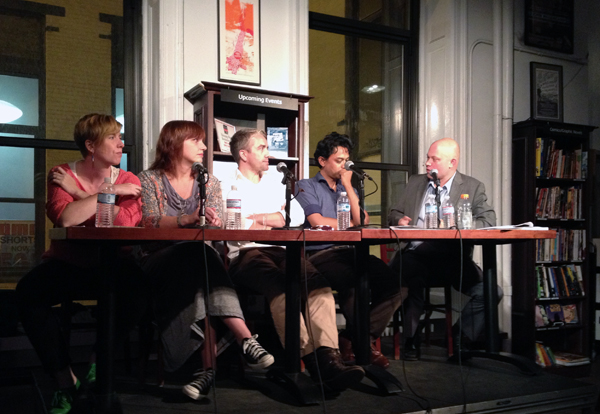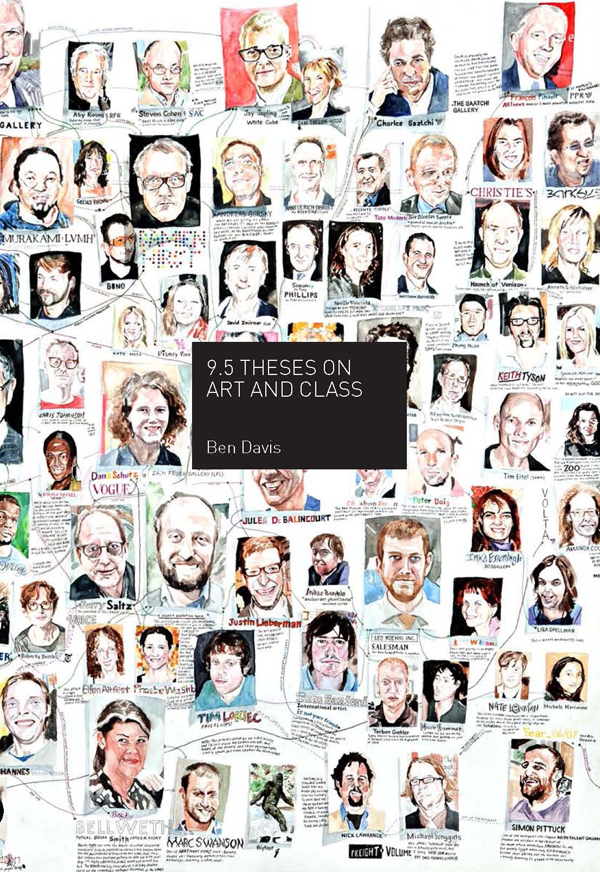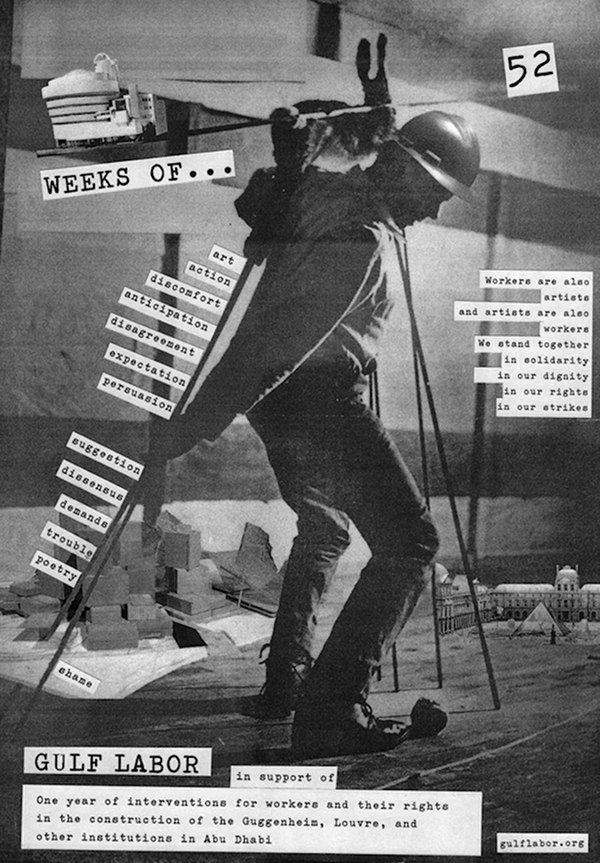How the Ruling Class Stole the Idea of Contemporary Art—and How to Get It Back
9.5 Theses on Art and Class with Ben Davis and Special Guests
Thursday, September 5, 2013
Housing Works Bookstore Café, New York
At the end of the first chapter of 9.5 Theses on Art and Class, the New York–based art critic and editor Ben Davis writes that a “theory of class might provide the missing center of the debate about art.” Indeed, the use, value, and status of art—especially in relation to politics and economics—have been the subject of a constantly flailing conversation since the Occupy moment, since the Great Recession, since the Bush years, since the rise of the biennial, since the Culture Wars, since Reagan, since Conceptual art, since Duchamp—okay, you get the point. It’s exactly this kind of exasperating, roundabout conversation that Davis wants to displace, and his new book does exactly that with resounding success.
Much of this success comes not from confrontation and agitation but rather through reason, logic, and clear thinking, which is perhaps why the book launch with a five-person panel last week was such a cordial affair. After giving a brief autobiography, Davis declared that the book comes from a new place, without the usual art vocabulary, and that he wants to bring together the art and activist communities. (The left-leaning Haymarket Books, known for titles on radicals and revolutionaries, published 9.5 Theses on Art and Class.) Many of its thirteen chapters had appeared over the years, in rougher forms, at Artnet.com, but the material also came from vigorous conversations with artists, dealers, critics, and activists. A significant moment for the author was #class, an exhibition cum seminar cum think tank cum rant room that was held in early 2010 at Winkleman Gallery. Davis’s contribution to the event was the enumerated “9.5 Theses on Art and Class,” a cumulative list of Marxist-informed positions that illuminates much of what is wrong—and what could be right—about the contemporary world of art. “So you’re calling for a Reformation?” the art dealer Edward Winkleman asked him at the time. Apparently so, and it’s about time.
In his talk, Davis summarized the distinctions and misconceptions among proper definitions of working, middle, and capitalist classes, which are elegantly covered in the first chapter. It’s not quite accurate to identify the middle class as based on income, education, or culture, but instead by the nature of a worker’s relationship to his or her labor. A middle-class person, Davis said, has agency, independence, and the ability to be one’s own boss. As an example he selected the mother of a Chicago-based activist and friend who runs her own cleaning business and employs two workers. Despite the type of work she does—maid service, really—this woman is middle class when compared to someone else in the same job at, for example, a hotel.
Taking the subject of a chapter in Julia Bryan-Wilson’s book Art Workers: Radical Practice in the Vietnam War Era (2011), Davis provided a second anecdote of class perception in art. For his solo exhibition at the Whitney Museum of American Art in 1970, Robert Morris turned the museum into a construction site, bossing around the workers who moved large pieces of timber, concrete, and steel. Despite an intention to appear as a working-class construction worker, he actually became a supervisor—a middle- or even ruling-class position—of a process piece involving forklifts, cranes, and pulleys, burning through hours of hired manpower. (Later on Davis proclaimed that blue-chip stars like Jeff Koons and Damien Hirst have exited art and become company floor managers.) Last, the author described a tension between the middle-class, noncommercial artist who fears of selling out (i.e., making money) compared to the working class, which purposefully fights for a bigger piece of the pie. This dual identity, hyperbolically described by some as schizophrenic, was a strong undercurrent for the panelists.

The class of 2013 (from left): Blithe Riley, Jennifer Dalton, William Powhida, Naeem Mohaiemen, and Ben Davis (photograph by Christopher Howard)
Starting the discussion, Blithe Riley, an artist, activist, and member of a collective that founded Interference Archive in Brooklyn, considered 9.5 Theses on Art and Class to be inspirational while raising important questions. The book, she felt, unwittingly presented the identity of artist as totalizing; it also doesn’t reflect the experiences of the museum and gallery workforce. Art is an “opaque economy,” Davis responded, acknowledging that a primary problem is that an artist, whose creative labor is middle class, must sometimes identify simultaneously with the working class through a day job (that dualism again). With New York in mind I thought immediately of artists working as art handlers and in entry-level positions and internships at commercial galleries and nonprofit organizations.
Jennifer Dalton, an artist whose work addresses sexism in the art world and an organizer of #class, had a problem with thesis 2.8: “Another role for art is a symbolic escape valve for radical impulses, to serve as a place to isolate and contain social energy that runs counter to the dominant ideology.” Not all art is radical, said Davis, whose observations in theses 2.0 to 2.9 explicate the roles of art for the ruling class, which of course do not foreclose other possibilities for creative labor. Dalton wanted to know about the political responsibility of artists and how it affects their practices: “When is an artist a citizen?” A better question, I think, would be “When is a person an artist and when is he or she a citizen?

William Powhida, How the New Museum Committed Suicide with Banality, 2009, graphite on paper, dimensions not known (artwork © William Powhida)
A veteran instructor for New York City public schools, the artist and #class conspirator William Powhida had started teaching this week and grumbled about the excessive time spent on administrative and evaluative duties that inevitably come with the position. He then conveyed his experiences as an artist with limited capital, which can be strained when studio accidents break expensive materials. With a corporate credit card for his practice—which is smartly registered as a limited liability company—Powhida has become that artist who produces work for art fairs, yet the majority of his income, he said, is derived not by selling his work with a gallery but through part-time teaching.
Powhida is well known for creating art that is abrasive to the upper echelons of the art world but wonders about the effect his work has on this elite. For instance, what is he supposed to do when the Greek shipping magnate and art collector Dakis Joannou buys a print of a drawing called How the New Museum Committed Suicide with Banality that he designed for the cover of the November 2009 issue of the Brooklyn Rail, which satirized a decision by the downtown institution, on whose board Joannou serves, to let Koons organize an exhibition comprising only his holdings? After laboring in his studio throughout the early days of Occupy Wall Street in fall 2011, Powhida later attended meetings of the Arts & Labor working group but after a couple months decided that his satirical and parodic approach didn’t fit in with it. Undeterred, he has recently partnered with a few Bushwick artists and scenesters to investigate purchasing a commercial building to provide affordable studios for artists in an effort to slow down gentrification.
Like Dalton, Naeem Mohaiemen, an artist, activist, and member of Gulf Labor, found thesis 9.0, which states that “The sphere of the visual arts is an important symbolic site of struggle; however, because of its middle-class character, it has relatively little effective social power,” to be contentious—if only as a call to arms to prove it wrong. He said that even a struggling artist has cultural capital and reiterated the evening’s recurrent notion of a person with multiple identities that cross class lines. To which group does an artist have a natural affinity, he asked, working or middle class? The answer is hard to produce here, but in other countries, he continued, divisions among classes are clear cut. Gulf Labor focuses on working conditions for migrant labor in the Middle East, that is, the ones who build the physical structures that house the institutions in which the art world works, such as the Guggenheim Abu Dhabi in the capital of the United Arab Emirates. People [in America] dismiss the subject, Mohaiemen said, because they believe that it is too complicated and that workers should be happy to have jobs. To people over there, a New York artist is part of an aloof elite.
Everyone seemed to agree that artists have tremendous amounts of symbolic power but not enough to mitigate rapidly growing inequality. What is the centralized institution against which to strike, Davis asked. Artists will keep making art, he proceeded, whether they sell it or not. Dalton contended that artists should boycott, not strike: “Don’t participate in what you don’t believe in.” The power of saying no is certainly one implicit goal of a group like Working Artists and the Greater Economy (W.A.G.E.). Similarly, Mohaiemen offered this advice to artists: “withhold and engage.”
Circling back to the gentrification issue, a man in the audience with a British accent propounded that artists never exercise community power in their neighborhoods, like immigrants do. It is true that certain cultures have roots while others don’t. Powhida reminded him that his current interest—collectively buying and operating a studio building—would not displace residents; it’s an endeavor that aims to take advantage of underused commercial property—and therefore give the participants an important stake in the community. The questioning continued: Would the artists sequester themselves from the community? Should they teach computer classes to their neighbors? To me, these lines of thought obscure the larger picture, and Powhida has the right idea. Gentrification in New York can generally be mitigated in two ways: by owning property and through rent stabilization. The focus of advocacy efforts should be on education and action, in particular, guiding residents through the legal, financial, and governmental landscape of property ownership while helping enforce the rights of those facing eviction and displacement. The encroachment of hipster bars and restaurants, and galleries and boutiques, is consequential but beside the point. We need lawyers and social workers, teachers and those with political connections, not artists.
One audience member contented that 9.5 Theses on Art and Class collapses politics into activism. “Professional revolutionaries” like Leon Trotsky or Hannah Arendt, he argued, would not think of themselves as activists. “Is activism your ultimate goal?” he finally asked. Davis briefly discussed his involvement with anti-racist, anti-prison, and anti-death-penalty groups, which he admitted has a narrow, limited scope. Yet helping people on a case-by-case basis, he hoped that this activity would have a larger impact. Powhida observed that Occupy Wall Street started large and fractured into working groups. The movement no longer has a discernible physical presence, amplified by the media and through confrontations with police, like it did in 2011, but instead operates on a smaller scale. I was reminded how Occupy Sandy mobilized relief efforts much quicker than established charities following the November 2012 hurricane.
Looking beyond New York, Riley has noticed, through conducting professional-development workshops with Creative Capital across the country, that people all over have different solutions. The “professional art world,” she implored, needs to “think bigger.” She also encouraged people to step away from the art world and get involved in social-justice issues. “There are a lot of wins,” she said, that just “may not be visible” to someone with a passing interest in activism and politics. Dalton wanted people to “hesitate less” and “pick up a shovel.” Ultimately, Davis’s book makes its readers dig deeper, asking them—us—what they value in art and in life.
In Terms Of count: 6.
Read
Carol De Pasquale, “And Then We’ll Dissolve the State,” In Terms Of, September 8, 2013.
Edward Winkleman, “The Paradox of the Artist Activist,” Ed_ Winkleman, September 6, 2013.




